Contributed by Quotient Travel Planner
Southeast Asia does have its fair share of UNESCO (United Nations Educational, Scientific and Cultural Organization) World Heritage sites. Since the region’s induction into the World Heritage hall of fame in 1991, it has seen a steady increase in the number of sites noted for their cultural and natural significance.
This year alone, three places were added — Mount Hamiguitan Range Wildlife Sanctuary in Davao in the Philippines, Tràng An Landscape Complex in the northern Vietnam province of Ninh Binh, and Pyu Ancient Cities, Myanmar’s first UNESCO World Heritage Site.
While there are to date 36 inscribed sites in the region — which is not that many considering Italy alone has 50 — few can name beyond a handful. Most may be familiar with the impressive Angkor ruins in Cambodia, Vietnam’s endearing Ha Long Bay and magnificent Hué monuments, and Indonesia’s revered Borobudur temple complex in Central Java or its unique Komodo National Park featuring the giant lizards, but there are plenty more that make the journey through Southeast Asia that much more enriching.
Here are five underrated UNESCO World Heritage sites to explore on your next Southeast Asia holiday.
Also read: 20 of the World’s Most Beautiful World Heritage Sites
Ban Chiang Archaelogical Site, Thailand
Year of inscription: 1992
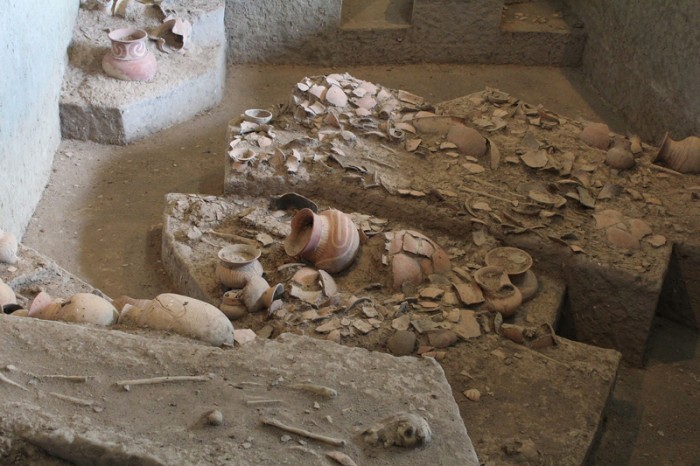 The excavation site at Wat Pho Si Nai near the Ban Chiang Museum reflects the practice of people buried with pottery. | Image credit: CC BY-SA 3.0 (Kiwiodysee, 2013)
The excavation site at Wat Pho Si Nai near the Ban Chiang Museum reflects the practice of people buried with pottery. | Image credit: CC BY-SA 3.0 (Kiwiodysee, 2013)
Nestled in the Udon Thani province of north-eastern Thailand, this oval mound measuring 500 metres by 1,350 metres by 8 metres was discovered in 1966 and is regarded as the most important prehistoric settlement discovered to date in Southeast Asia. Inscribed in 1992 as a cultural site, Ban Chiang reveals agrarian lifestyles between 1,495 BC and 900 BC through artefacts uncovered such as farming tools and ceramics including for burial purposes. Visitors’ understanding of the archaeological wealth of Ban Chiang is aided by the museum located at the site; one of the excavation sites is also properly preserved for viewing.
Gunung Mulu National Park, Malaysia
Year of inscription: 2000
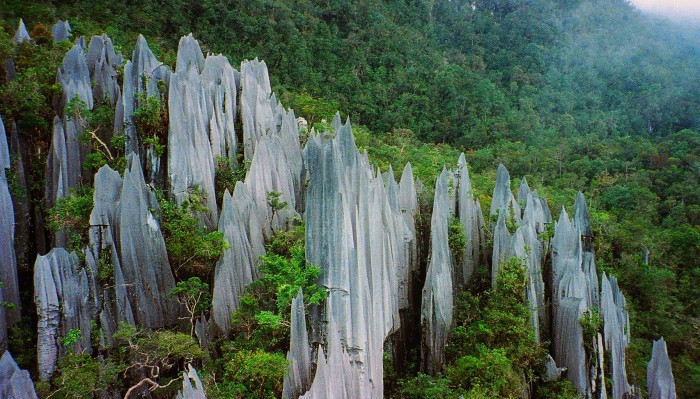 Image credit: Karsts in Gunung Mulu National Park: CC BY 2.0 (Paul White, 2008)
Image credit: Karsts in Gunung Mulu National Park: CC BY 2.0 (Paul White, 2008)
Home of the Sarawak Chamber, the largest cave chamber in the world, the Gunung Mulu National Park (pictured above) occupies over 52,000 hectares in northern Sarawak, near the border with Brunei. This park dominated by the 2,376-metre high Gunung Mulu is geologically endowed — UNESCO calls it the “most studied tropical karst area in the world” — and boasts 295 kilometres of explored caves that have origins as far back as 1.5 million years. Other than bats and other cave residents, there are plenty of fauna spread throughout the forest, which is further classified into 17 vegetation zones showcasing some 3,500 plant species. There will also be opportunities to get up close to the orang ulu or ‘up river’ people; many communities have resided within the park boundaries for millennia.
Lorentz National Park, Indonesia
Year of inscription: 1999
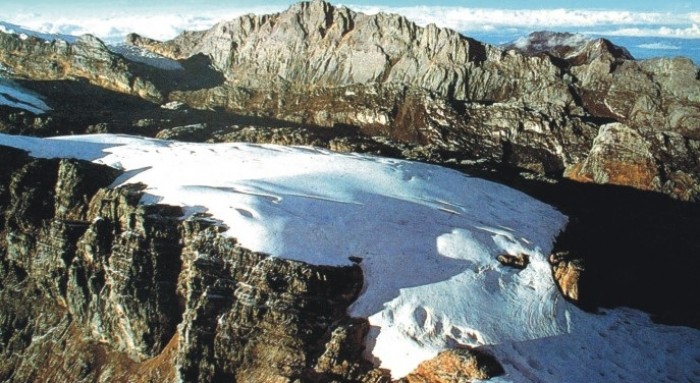 The Puncak Jaya, one of only three tropical glacier places in the world, dominates Southeast Asia’s largest national park. | Image credit: CC BY-NC-SA 2.0 (pjriccio2006, 2006)
The Puncak Jaya, one of only three tropical glacier places in the world, dominates Southeast Asia’s largest national park. | Image credit: CC BY-NC-SA 2.0 (pjriccio2006, 2006)
The largest protected area in Southeast Asia, Lorentz National Park stretches a whooping over 2.5 million hectares in the Papua province of Indonesia, west of Papua New Guinea. It has the honour of being the only conservation area in the world to boast a continuous environment encompassing snow-capped mountains, wetlands and tropical marine waters of the Arafura Sea. The Carstenz or Puncak Jaya also joins the Sierra Nevada region in the Andes and Mount Kenya of Kilimanjaro in East Africa to form the trio of equatorial highlands with sufficient altitude to retain permanent ice, although global warming is taking a toll on the Lorentz ice fields. Given the extensive area, there is an extraordinary level of endemism and outstanding biodiversity and cultural diversity. Among the animal species recorded here are the short-beaked and long-beaked echidna, Dingiso tree kangaroo and Macgregor’s bird of paradise.
Phong Nha-Kẻ Bàng National Park, Vietnam
Year of inscription: 2003
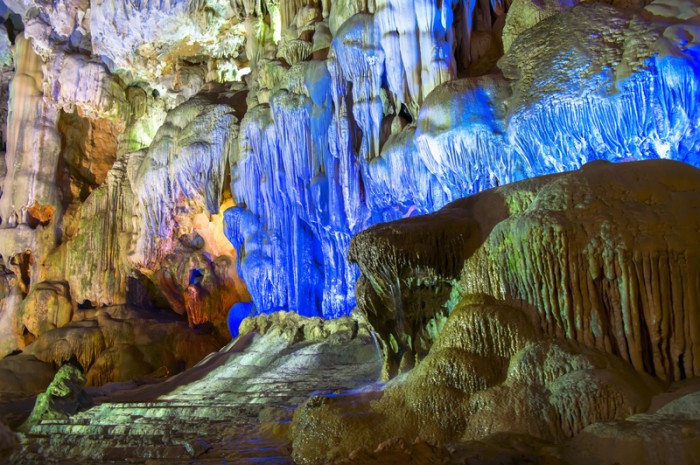
Vietnam has been in the spotlight for its caves and despite Phong Nga being known domestically and among some quarters of the international community, this 11-year-old UNESCO gem still remains somewhat hidden in the shadows. Asia’s oldest karst area, the Phong Nha-Kẻ Bàng National Park in central Vietnam’s Quảng Bình province sharing a border with the Hin Namno Nature Reserve in Laos has a complex landscape that dates back 400 million years. The system of different cave types and underground rivers stretches 104km, and the 85,754-hectare national park also comprises dense forest, savannah and streams. The rich biodiversity is epitomised by the balanced range of mammals, reptiles, birds and fish; threatened species such as the Asiatic black bear, Asian elephant and saola or Asian unicorn have been sighted here.
Puerto Princesa Subterranean River National Park, Philippines
Year of inscription: 1999
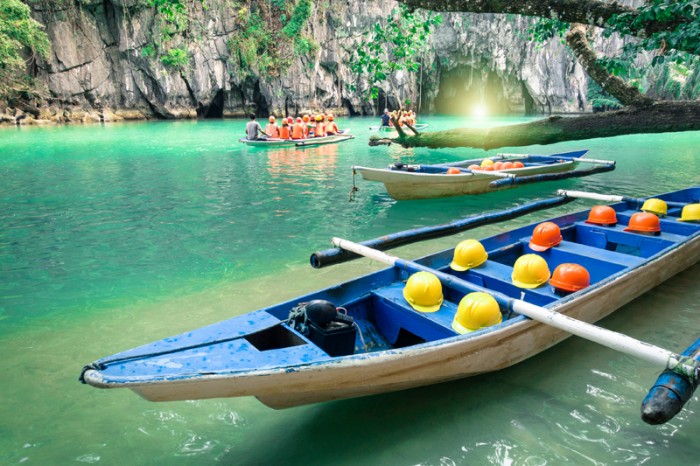 The calm entrance of the caves contrasts with choppy waters at the boat landing to the attraction. Tours are sometimes cancelled due to the stormy seas.
The calm entrance of the caves contrasts with choppy waters at the boat landing to the attraction. Tours are sometimes cancelled due to the stormy seas.
Situated on the western coast of Palawan island, the Puerto-Princesa Subterranean River National Park is regarded as one of the New 7 Wonders of Nature. The underground river, spanning 8.2 kilometres but only 4.3 kilometres of which are navigable, empties out directly to sea, having the rare phenomenon of being subject to tidal influence. The pristine condition of the complex caverns and varied ecosystem underscore the beauty and significance of the park. Endemic species including the Palawan porcupine, Palawan stink badger and Palawan peacock pheasant are found here, and eight species of bats are known to reside in the caves.
Divers will also want to grab the opportunity to head out from Puerto Princesa city to the Tubbataha Reefs Natural Park in the Sulu Sea off Palawan. Also a UNESCO site, the park offers an underwater paradise in the heart of the Coral Triangle or Amazon of the seas, featuring marine stars such as whales, sharks, dolphins and turtles as well as an amazing array of fish.
Also read: Afraid of the dark? Wait Till You Enter Palawan’s Underground River.
|
Marvel at these UNESCO sites in Southeast Asia. You’d be happy to know that Quotient TravelPlanner specialises in bespoke travel, so that you can make that desired trip happen according to your preferences. Start building that epic holiday today, or choose from one of their many Ready To Tour packages. |





